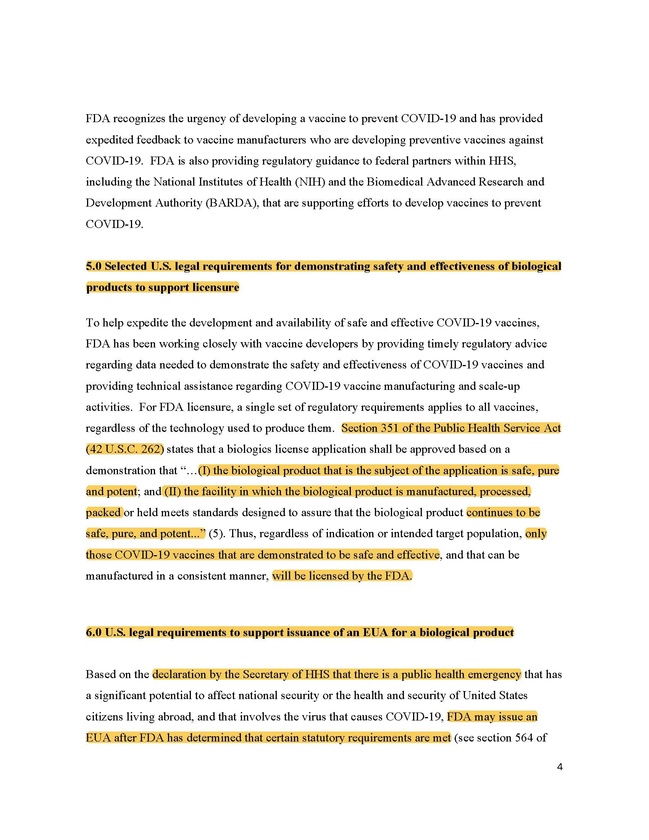2% max recommended unless otherwise noted. 1% max recommended for soccer.
III. TECHNICAL CONTEXT: STERILIZING IMMUNITY AND REGULATORY DEFINITIONAL SLIPPAGE
The concept of sterilizing immunity—the complete elimination of a pathogen before it can replicate in the host[1]—has long served as the gold standard for vaccine evaluation. Yet no vaccine has ever been 100% effective in achieving it[2]. This is not a new insight. In fact, when the CDC revised its public definition of "vaccine" in September 2021, its stated reason—quoted in an AP fact check—was precisely that[2]:
“The previous definition could be interpreted to mean that vaccines were 100% effective, which they never have been”.
That statement is technically correct. Even among traditional vaccines, real-world performance varies. Consider the mumps component of MMR: outbreaks today occur primarily among vaccinated populations[3], and immunity is known to wane substantially after 20–30 years[4,5]. A 2022 review noted that even two doses conferred only 88% median effectiveness[5], with lower efficacy against circulating genotype G strains[6]. Similarly, studies comparing natural infection with measles versus vaccination show longer-lasting immunity from wild-type exposure than from the vaccine[7].
What’s important is that these limitations were known—and yet, under the pre-2021 definition[8–10], these products were still considered vaccines, because they very often prevented transmission and reliably induced long-term protection, even if not perfectly.
That’s what changed in 2021[11].
The Direction of Definition: From Immunity to Protection
Until 2021, the CDC defined a vaccine as:
“a product that stimulates a person’s immune system to produce immunity to a specific disease” (2015-August 2021 definition)[8–10]
After the September revision: “a preparation that is used to stimulate the body’s immune response against diseases”[11]
This change is subtle but profound. "Immunity" implies a system state—resistance to infection. "Response" merely implies a reaction. As regulatory language, that shift relaxes the evidentiary burden. It enabled the introduction—and mass authorization—of COVID-19 biologics that reduce symptom severity but do not block infection or transmission.[12]
A Break from Historical Baseline
Traditional vaccines weren’t 100% sterilizing, but many came close:
By contrast, a 2023 meta-analysis published in JAMA Network Open pooled 40 high-quality studies and found that vaccine effectiveness against Omicron symptomatic disease was <20% at 6 months, and <30% even after boosters[17]. This is not "protection" as the public understands it. Under the pre-2021 regulatory framing, a biologic with this performance profile would not plausibly be labeled a vaccine.
Yet by replacing “immunity” with “response,” it now qualifies.
What the Change Enabled
New vaccine concepts have emerged that wouldn’t have met earlier standards. One example is a 2024 white paper by Arunachalam proposing “homeostatic immunity”, where vaccines are designed to modulate the immune system—not eliminate pathogens. The author explicitly frames this in terms of CDC’s new “protection” model, not sterilization[18].
“Vaccines generate Goldilocks immunity, balancing pro- and anti-inflammatory signals…” — Arunachalam (2024)
This is a fascinating and potentially powerful approach. But it would not have satisfied the historical understanding of a vaccine. Don’t harangue him for what sounds like a cool idea.
From Technical Precision to Legal Drift
This definitional slippage has consequences beyond terminology:
Conclusion
No vaccine was ever perfectly sterilizing. But most were good enough that the colloquial understanding of a vaccine—something that keeps you from getting or spreading a disease—remained broadly true.
That is no longer the case.
The CDC’s 2021 definition change opened the gate for a different kind of product—one that would never have met the evidentiary bar of “immunity,” but can now pass under the softened standard of “response.”
It wasn’t the pathogen that changed. It was the word.
Footnotes / References (Nature Format)
1. Wahl, I. & Wardemann, H. Sterilizing immunity: Understanding COVID-19. Immunity 55, 2231–2235 (2022).
2. Experts say changes to CDC’s vaccination definition are normal | AP News. APhttps://web.archive.org/web/20220209232529/https://apnews.com/article/fact-checking-976069264061 (2022). 3. Rubin, S. A. et al. Recent Mumps Outbreaks in Vaccinated Populations: No Evidence of Immune Escape. J Virol 86, 615–620 (2012).
4. Lewnard, J. A. & Grad, Y. H. Vaccine waning and mumps re-emergence in the United States. SCIENCE TRANSLATIONAL MEDICINE (2018).
5. Connell, A. R., Connell, J., Leahy, T. R. & Hassan, J. Mumps Outbreaks in Vaccinated Populations—Is It Time to Re-assess the Clinical Efficacy of Vaccines? Front. Immunol. 11, (2020).
6. Gouma, S. et al. Mumps-specific cross-neutralization by MMR vaccine-induced antibodies predicts protection against mumps virus infection. Vaccine 34, 4166–4171 (2016).
7. Bianchi, F. P. et al. Long-term immunogenicity after measles vaccine vs. wild infection: an Italian retrospective cohort study. Human Vaccines & Immunotherapeutics 17, 2078–2084 (2021).
8. Immunization Basics | CDC - 01/09/19. CDC - Immunization: The Basics - 01/09/19 The Wayback Machine - https://web.archive.org/web/20190109174625/https://www.cdc.gov/vaccines/vac-gen/imz-basics.htm (2019).
9. CDC - Vaccines: Vac-Gen/Imz Basics - 03/17/20. CDC - Vaccines & Immunizations: The basicshttps://web.archive.org/web/20200317214611/https://www.cdc.gov/vaccines/vac-gen/imz-basics.htm (2020).
10. Immunization Basics | Vaccines and Immunizations | CDC - 01/31/21. Immunization Basics | Vaccines and Immunizations | CDChttps://web.archive.org/web/20210131134831/https://www.cdc.gov/vaccines/vac-gen/imz-basics.htm (2021). 11. CDC - Immunization: The Basics - 10/31/21. CDC - Immunization: The BasicsCDC_Vaccine_def_01_31_21 (2021).
12. Brennan, O. C., Moore, J. E., Moore, P. J. A. & Millar, B. C. Vaccination terminology: A revised glossary of key terms including lay person’s definitions. Clinical Pharmacy Therapeu 47, 369–382 (2022).
13. Taub, D. D. et al. Immunity from Smallpox Vaccine Persists for Decades: A Longitudinal Study. The American Journal of Medicine 121, 1058–1064 (2008).
14. Wright, P. F. et al. Vaccine-induced mucosal immunity to poliovirus: analysis of cohorts from an open-label, randomised controlled trial in Latin American infants. The Lancet Infectious Diseases 16, 1377–1384 (2016).
15. Brickley, E. B. & Wright, P. F. Maximising the impact of inactivated polio vaccines. The Lancet Infectious Diseases 17, 680–681 (2017).
16. Franconeri, L., Antona, D., Cauchemez, S., Lévy-Bruhl, D. & Paireau, J. Two-dose measles vaccine effectiveness remains high over time: A French observational study, 2017–2019. Vaccine 41, 5797–5804 (2023).
17. Menegale, F. et al. Evaluation of Waning of SARS-CoV-2 Vaccine–Induced Immunity: A Systematic Review and Meta-analysis. JAMA Netw Open 6, e2310650 (2023).
18. Arunachalam, A. B. Vaccines Induce Homeostatic Immunity, Generating Several Secondary Benefits. Vaccines 12, 396 (2024).
19. FDA. Vaccines and Related Biological Products Advisory Committee Meeting. (2020).

Discount Code: BARNES for 50% off annual subscriptions; this reduces the price to less than a dollar a day! Every year we have been operating has produced a greater profit than that cost for the average $50/pick investor. Indeed, if we don't double your subscription investment by next August for those making as low as $20/pick bettors, then you will get a free subscription for the next year. Discount ends August 4.

